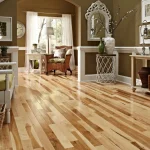- August 10, 2024
The flooring of your kitchen is the most important one. It should be durable, easy to clean, and, obviously, fit your house design. Like any other industry, there are dos and don’ts of kitchen flooring. And we’re here to cover everything for you.
When we imagine the kitchen, what do we see? I personally see moist, a lot of people, and of course great food. So, in my imagination, the kitchen floor is durable enough to bear all the stuff that’s happening. That’s why we have created a list of top picks for the kitchen floor.
Top 5 Kitchen Flooring Options For You
Let’s take a look at a few ideas that you may want to consider!
1. Ceramic or Porcelain Tiles
Ceramic-tiled kitchens are unbeatable when it comes to functionality, durability, and looks. This flooring option handles any splashes or stains as a product of cooking or preparing food like a pro, not to mention that it’s resistant to heat and water.
You’ll also love the wealth of color and texture options available on the market, anything from light and cheerful-looking to dark and elegant. So, whether you want your kitchen to lean toward the retro style, industrial, or ultra-modern, you’re bound to find suitable ceramic tile choices that’ll fit in perfectly!
Porcelain tiles have the same characteristics, too, but you may find them at larger dimensions. This is a plus point if you’re a fan of smaller gaps between tiles and an almost seamless appearance. Just keep in mind that porcelain tiles are naturally more brittle than ceramic.
Also, note that ceramic and porcelain tiles aren’t as sturdy as some other materials, like concrete, brick, and natural stone. You can expect them to last a lifetime with normal use, though.
2. Natural Stone Tiles
Another great flooring option for fans of tiled floors is natural stone, as it adds an unmatched earth-inspired beauty to the aesthetics of your home. Even better than its decorative value are its physical properties, as it’s incredibly impervious to moisture, heat, and impact.
What’s more, natural stone tiles exceed luxury and even boost the value of your home on the market.
While granite is decidedly the most durable option you’ll come across, there’s also marble, sandstone, limestone, slate, and travertine.
Each one of these materials has distinguishable textures, colors, and even hardnesses. So, make sure to do your research on each natural stone to see which one matches your needs in a kitchen.
Natural stone’s main drawback is that it’s the most expensive kitchen flooring you’ll find. Another downside is that stone is porous, which will require kitchen users to be very careful not to spill any liquids that might cause discoloration.
3. Hardwood
Hardwood is another popular kitchen flooring that works for different interior styles, as you’ll find it in a multitude of textures and colors. Ultimately, many people favor it because it gives their homes cozy vibes, and it even increases resale value.
Also Read: Top 9 Benefits of Hardwood Floors
You can go for oak, walnut, cherry, and maple, as they’re the most aesthetically appealing. You may also choose engineered wooden planks that have a hardwood veneer, which offer a larger variety of color options.
However, the thing that isn’t very cool about hardwood is that it’s still susceptible to water damage despite all the treatment it gets from modern sealers. It can also stain and dent pretty easily.
4. Concrete
What’s a better flooring material for an industrial or raw organic-style kitchen than concrete? This material will definitely complement the design of your kitchen and give you that edge you’re looking for.
Aside from its looks, concrete excels at being a viable kitchen flooring option in terms of durability, as it’ll handle all forms of wear and tear. No dents, scratches, or stains to report here (but you must properly seal it to battle its porous nature)!
It’s also incredibly resistant to heat, which is another factor you need to keep in mind when picking a flooring material for your kitchen. Better yet, it’s one of the most affordable materials out there.
Still, nothing comes without cons, and one major drawback of concrete is that it’s heavy. Unless your kitchen is at ground level (and there’s no basement), you may jeopardize your house’s structural integrity if the kitchen is on an upper floor.
In addition, concrete can feel too hard underfoot, which won’t appeal to people who are used to the softer sensation of hardwood floors.
5. Cork
Cork is a relatively new kitchen flooring material, but you don’t want to underestimate its countless benefits. For starters, it’s sustainable and recyclable, which is great news if you want to contribute to the global green movement.
Plus, it has a unique appearance that’s sure to turn heads and provoke the curiosity of everyone who enters your home. Cork also feels a bit soft under your feet, just like wooden floors, promoting vibes of immense comfort.
Yet, you must remember that this material is prone to scratches and moisture damage, which is why sealing it every year or two is the way to go to enhance its durability.
There are other flooring options that we’d also recommend having a look at:
Final Words
After reading our guide, all that’s left to do is consider your use and budget when choosing a flooring option for your kitchen. Whatever flooring you choose, hiring a reliable, professional flooring installation company is a must.
Luckily, we at Elephant Floors are ready to inspect your kitchen and install your chosen flooring. Call us today or schedule an appointment via our website to get in touch with our team of experts.




